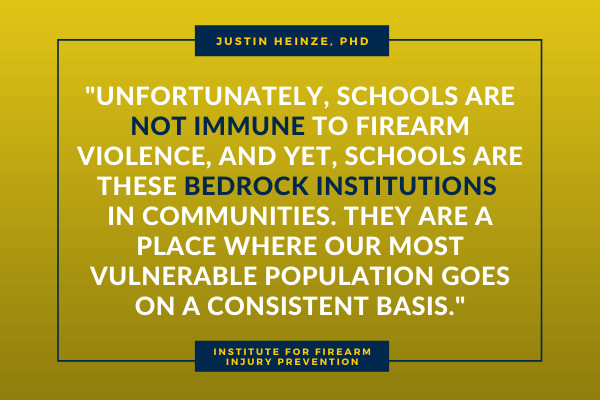State Laws and Risk Among K-12 School Shooting Incidents

This project aims to evaluate whether the permissiveness-restrictiveness of state gun laws has an effect on the number of K-12 active school shootings. The project team will evaluate county level differences in both restrictiveness/permissiveness and outcomes of specific firearm laws for K-12 active school shooting incidents, and the association between the number of bullets fired and state firearm laws in K-12 school shootings. This project will lay the foundation for future studies to better understand the underlying causes of school shootings. Results will inform policy and practice to reduce the incidence of firearm related incidents that negatively affect adolescents’ health and productive learning.
Abstract
Introduction: Within the last six years, the United States experienced the two most deadly K-12 school shootings in its history. The Sandy Hook Elementary School shooting left 28 dead, including 20 school children. More recently, seventeen students were killed in Parkland, Florida when a gunman opened fire. These events have reignited the need for research on gun violence in America; however, there has been little, if any, research done to understand the associations or factors behind school wide shootings. This is complicated by the fact there is no agreed upon definition (or database) for both mass shootings or K-12 active shooting incidents in the United States. In order to better understand the factors behind school shootings, the broad objectives of this proposal are to evaluate whether different state laws are associated with K-12 shootings in the United States.
Objectives: Broad objectives of this study are to understand whether different state laws are associated with K-12 shootings in the United States. The project aims to create knowledge to inform policy and practice to reduce the incidence of firearm related incidents that negatively affect both adolescents’ health and their opportunity to have a productive learning environment.
Specific Aims:
Aim 1. Evaluate whether the permissiveness-restrictiveness of state gun laws had an effect on the number of K-12 active school shootings.
- Aim 1A. Evaluate differences among scores of permissiveness-restrictiveness.
- Aim 1B. Evaluate whether the state gun ownership had an effect on the number of K-12 active school shootings.
Aim 2. Determine if, and to what extent, specific state-level firearm laws have on the outcome of K-12 school shootings.
Aim 3. Evaluate county level differences in both restrictiveness/permissiveness and specific firearm laws and the outcome of K-12 active school shooting incidents.
Aim 4. Evaluate the association between number of bullets fired and state firearm laws in K-12 school shootings
Aim 5. Submit a large-scale project proposal (e.g., R01)
Project Team
Funders
Funders
Children’s National Hospital
Michigan State University
Teachers College, Columbia University
University of Washington